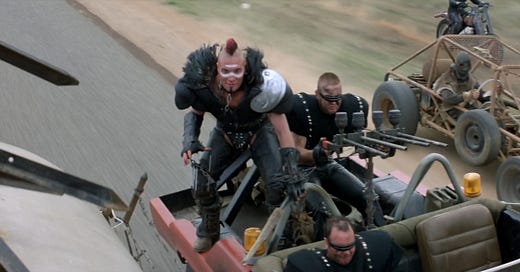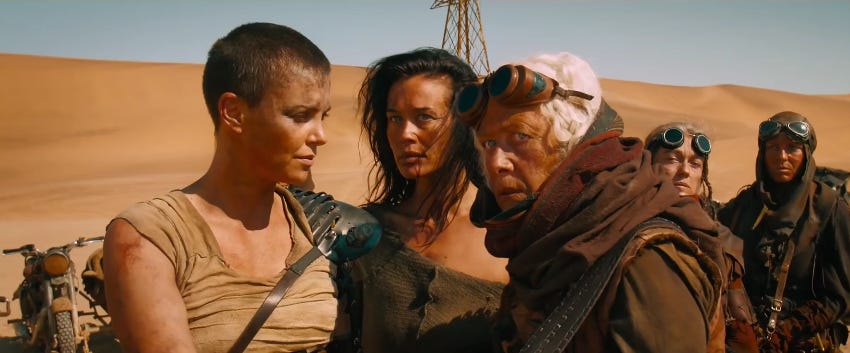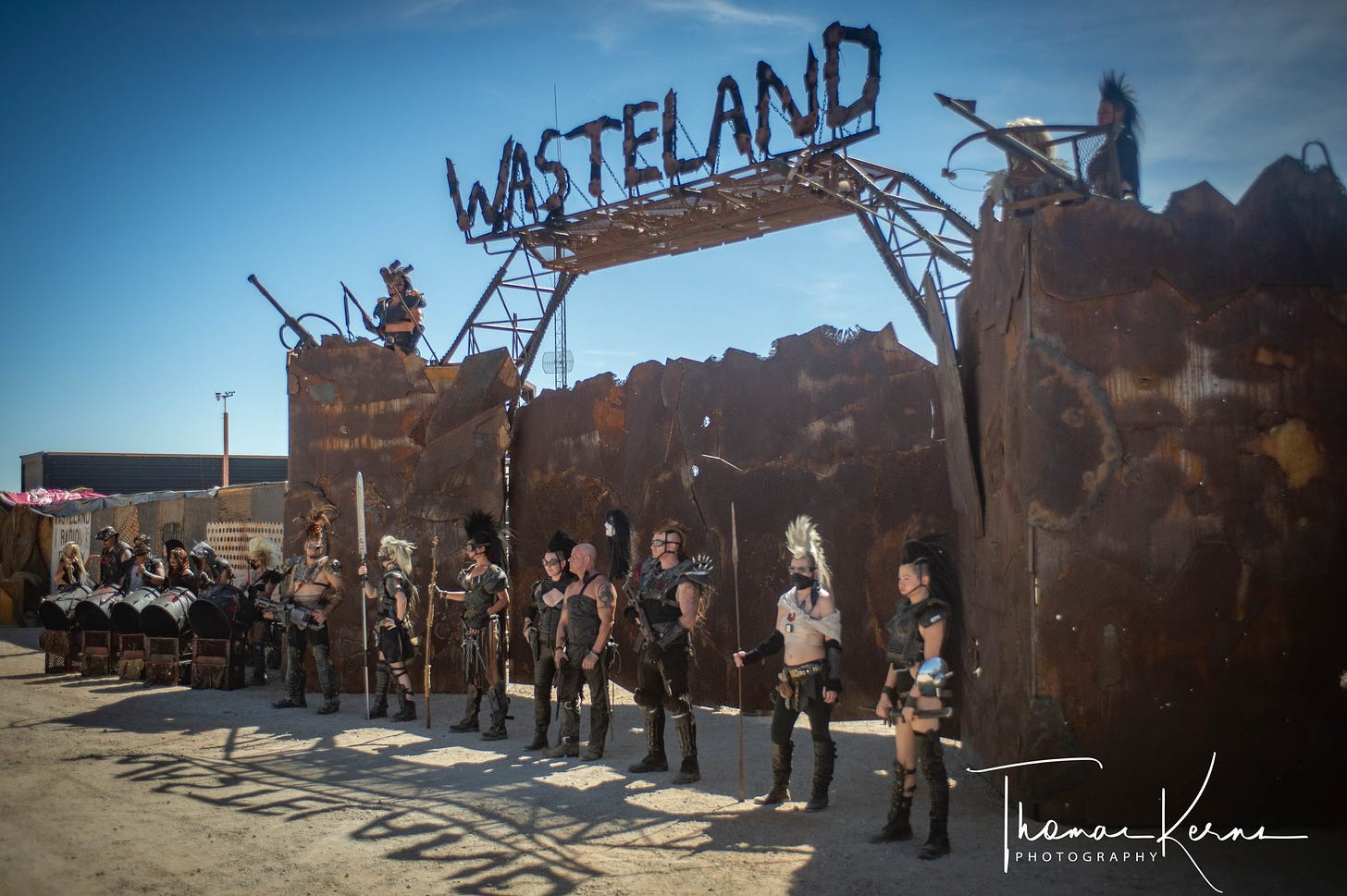The Mad Max Saga is anything but predictable. In 1979, George Miller and crew released a biker exploitation flick starring a young unknown named Mel Gibson as a highway cop. Famous for its great car stunt work and a brutal and unforgettable ending, it was a cut above the rest of its genre. But that genre was mostly dead in the nuclear terror of the ‘80s, and when they brought Max back, his story shifted to a post-apocalyptic wasteland ruled by road warriors on the hunt for food, gasoline, and victims.
The Road Warrior is probably the most famous of its kind, both as a Mad Max film and the post-nuclear war genre. You may prefer the unflinching realism of Threads or the thoughtful, low-budget cheesiness of Cherry 2000, but you can’t deny the mark this one left on the culture. Along with the kid-friendly sequel Mad Max Beyond Thunderdome, featuring a nicer Max and an incredible Tina Turner as the leader of Bartertown, these movies define the “look” of a post-nuclear apocalyptic civilization, as depicted in video game series such as Fallout, which is now an excellent streaming show.
I’ll get back to Fallout later. In most cases, returning to a franchise thirty years later, with or without the star, would make for a box office flop and a critical disaster. Mad Max: Fury Road, which embraced the colon in its title and kicked its racist, abusive star into a still-glowing nuclear impact crater, exceeded all expectations and goals. Thomas Hardy takes over as Max, with Cherlize Theron co-starring as Furiosa, a “war rig” driver for a tyrannical warlord named Immortan Joe who rules a Citadel built on an aquaduct. Joe withholds water from his serfs and enslaves beautiful women as breed mares, and Furiosa—a captive from a lost oasis known as the Greeen Place—makes her escape with a war rig full of gasoline and the freed women. This one is nearly pure action, beginning with Max’s capture and almost continuously following road chases and battles into the wasteland and back.
To some it is brilliant and exhilarating; others feel like Roger Ebert after watching Aliens, feeling drained from the experience. Fury Road surprised many, an action film worthy of being called cinematic art, which was re-released in black and white to emphasize that its practical and computer-generated effects alone were not what dazzled audiences; it was a masterpiece of framing, editing, and both visual and written storytelling. We learn more about the Wasteland as we rush long in its story than in the three previous films.
Furiosa has big wheel wells to fill, and to its credit, it does not try to exceed its predecessor in all ways. It is there to tell Furiosa’s story, and it does so well. We follow her from childhood, to her capture by bandits, and her survival instinct that turns her from a scavenger to a fighter to a driver with a new partner: Praetorian Jack, a war rig driver who sees her fast reflexes and cunning and hones them so they can keep each other alive. There’s plenty of action, in places only mentioned before: Gastown, the Bullet Farm, and the home of the Vuvulini, the sniper biker women who are the plague of rapacious nomad gangs. Immortan Joe and his sons still rule the Citadel, but compared to Chris Helmsworth’s Dementus, they seem reasonable.
We have time to rest and reflect and observe, while never becoming bored. It does become a revenge story, which takes some of the steam out of it by the finish. We know where it must end, with Furiosa working for the tyrant Immortan Joe, but we see by then that Furiosa bides her time and takes revenge and redemption when they are served best. Cold and calculating.
I saw Furiosa in Cinemark XD, a kind of half-IMAX, and it was a great evening in another world. If you don’t want to leave home, but want to visit the Wasteland, I also recommend the Amazon Prime series Fallout, which takes the best parts of a satirical, darkly funny, and imaginative video game world and brings it to life in vibrant color with pitch-perfect delight. What makes the Fallout games so enjoyable is the immersive diesel-punk atomic ‘50s alternate history, where every home has a cathode ray TV and a floating, talking octopod robot called Mr. Handy, and nuclear war is so inevitable that Hollywood cowboys pitch spots in underground Vault bunkers as investments for your family’s future.
The series shifts between the age just before the bombs fell and centuries later, when descendants of the Vault dwellers crawl out seeking parts to keep their machines running, and find radioactive ghouls who need drugs to keep from going full cannibal, enormous monstrosities that look like a Gila Monster humped a giant freshwaster catfish, knights in nuclear-powered flying armor suits, and Bartertown villages where people trade bottle caps for fried lizard on a stick, or for Larry’s Limbs, a device sold in the general store that can replace your foot when someone blasts it off with a shotgun.
Fallout is very bloody, like the game, because life is cheap in the wasteland. But even the nasty bandits who fall before the Ghoul’s six-gun are granted pathos and enough character that you can imagine their full lives before their gory demise. They are roleplaying games at heart, where your behavior marked your character with badges or stains depending on how you made your way through the wastes. Childkiller. Sexpert. Champion.
There are Easter eggs galore for lovers of the games, but neophytes won’t be confused. You don’t need to know why Lucy is so good-hearted, why Maximus is so lucky, and why the Ghoul shoots like he’s in The Quick and the Dead, but those of us who played through the games over and over, trying out sneaks, goody-goods, psychos, lucky dummies, hapless geniuses, unarmed karate savants, anemic snipers, and clever charismatic weaklings, know that there are many ways to survive the apocalypse, and you don’t have to be as tough as Mad Max if you’re clever enough to slip a live grenade into a warlord’s pocket and flee before it explodes, or talk a Deathclaw into joining your crew, or hack into a computer and get it to release all the prisoners, so the sane ones flee and the crazed cannibals devour your captors.
The games had a specific tone of amused, ironic fatalism that the show captures perfectly. The wasteland is full of wonders, not merely irradiated terrors. The people just want to get by, or they want to kill you for your shoes, or they want to talk to you and see if you’ll rescue their uncle the prospector from the Gecko people, or clear their mine of Wanamingos. The show evokes this weirdness without overdoing it. My favorite line? “I should’ve known better than to trust a doctor who smelled like that!”
Oddly enough, I find post-apocalyptic movies fill me with hope. I have no expectations of surviving a nuclear war, and I don’t want us to be the only creatures left on Earth except for the odd lizard who gets eaten raw, or fried on a stick. I see them as cautionary tales, that we know where we are headed unless we change course. I don’t think anyone leaves these movies thinking they should vote against the military-industrial complex, or believe in climate change, but I don’t think any of us who love these stories—even the folks who gather in the Mojave desert for Wasteland Weekend every year—want to see this future come to pass.
If my cross-country road trip happens, I will be attending Wasteland Weekend this year. I may even deck out my spare fat tire bike as a wastecycle. If I go, I won’t be camping out, I’ll find a nearby motel. No scorpions in my boots, thanks. (Or Rad-scorpions in my tent.)













Wow, I had no idea Wasteland week existed. Like Burning Man for the disillusioned (who still like illusions)?
I loved Furiosa but haven't watched Fallout ... yet. I want to see Furiosa again in the big theater. I didn't realize that it was a prequel to the degree that it essentially ends where Fury Road begins. But man, was it a lot of fun and a feast for the eyes.